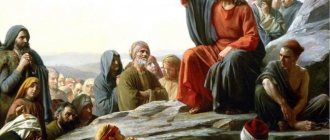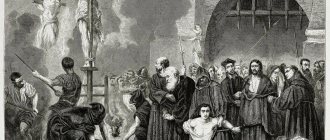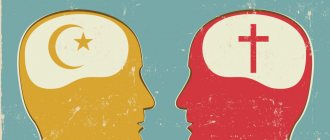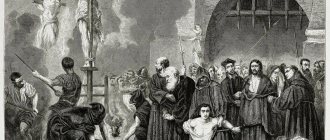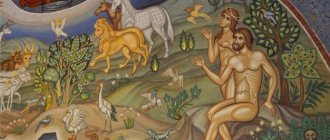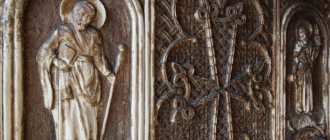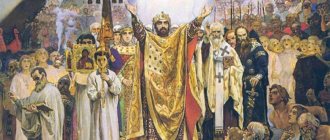Please do not take this article as criticism for the sake of criticism. The purpose of this article is to set some milestones by which you can navigate in the search for personal happiness and peace of mind. Christianity has had a deep influence on our culture and many of the spiritual problems that we all face are generated by it - that’s what we’ll talk about.
Let's start with the fact that Christianity, like any religion, has nothing to do with God. Christianity talks about God, but has no direct connection with him. This is exactly the case when it should be recalled that only those who have eaten them have the right to talk about the taste of oysters. So, the creators of Christianity did not eat oysters.
Christianity, as a systematized teaching, did not arise spontaneously or suddenly; it was created , and not just like that, but with very specific practical goals. As Nietzsche says, there was only one true Christian - Jesus. Jesus embodied Christianity—he was a Christian. And everyone who later stood under the banner of the new religion only believed .
Remember the main motive of the Tao Te Ching - the Tao that has a name is not the real Tao. So is Christianity - being expressed in words, it loses all meaning. No words or signs can convey the inner state of Jesus - he simply lived and set an example of the salvation of the soul. And Christianity is “faith in Jesus,” not invented by him, but put into his mouth.
In psychology, this problem constantly becomes a stumbling block - people often do not see the difference between faith and knowledge. By accepting other people's words and principles as the immutable truth, people refuse the need to gain their own experience and wander into such a jungle from which they themselves can no longer get out. The more a person relies on other people's opinions and ideals, the sooner he loses ground under his feet and finds himself in limbo - life becomes a complete abstraction, devoid of taste and color.
Christianity, as it was formed, is just a set of legends and traditions about the lives of holy people. There is no power in him - only fairy tales about it. All documents testifying to ancient great achievements are impressions recorded from hearsay, altered many times in accordance with the requirements of the moment. Behind each text are living people who followed their goals and the current situation.
And yet, on the basis of these stories and retellings, a huge philosophical and ontological concept is built, with the claim that it came from the hands of God himself. However, nothing can change the fact that the basis of religion is faith, not knowledge. Religion is created and propagated by people who, at best, believe in God, but who do not have any personal knowledge of what God is and where to look for him.
Here it is necessary to make a reservation that at all times there have been truly holy people in the bosom of the Christian church. The saints were not because they clearly and wholeheartedly followed all the tenets of religion, but because they made the transition from faith to knowledge of God. They no longer believe, now they Know. And the fact that, when talking about their experiences, they use Christian terminology is just a matter of habit and the need to find at least some words for indescribable revelations.
Achieving such a state is not the merit of Christian teaching and not the result of a righteous life. People achieved the same state without any mediation of religious teachings. Enlightenment, restoration of connection with God, is the result of honesty with oneself and seeking support within, in one’s own psychological experience, and not in external teachings and rules. Christianity claims that only those who obey it will be saved, and all others will be punished.
So there is a huge gulf between the salvation of the soul and the actual values of the religious institution that we know Christianity as today. And if, in its best intentions, religion really wants to help bridge this gap, then in practice the opposite happens - it only hinders the salvation of the soul.
Early Christianity
Christianity was not always a religion; in the initial stages of its existence, it was a sect. Not in the negative sense in which it is customary to use this word today, but in its original meaning, as a brotherhood that has accepted its own separate doctrine of faith. Breaking away from Judaism, early Christianity was a Mystery - the doctrine of the awakening of spiritual powers and the achievement of a higher state of soul.
Like all other Mysteries, early Christianity was a practical teaching. Not by faith for the sake of faith, but by a system of practical knowledge with its own language and its own techniques for awakening the soul from sleep. And only those who were prepared and worthy were allowed access to this mystical knowledge. Revealing the subtleties of spiritual truths to the profane was considered dangerous, which is wonderfully illustrated by the story of Jesus himself.
Later, when Christianity began to become more widespread, its main component was forcibly eradicated from it. Being a Mystery, Christian teaching had as its goal the achievement of the same state of soul in which Jesus was. But already several centuries after the death of Jesus, all that remained of original Christianity was an emasculated faith in the forgiveness and salvation promised to the righteous.
Christ - like Buddha - differed from other people in actions, but Christians from the very beginning differed from others only in faith.
Karl Jaspers
Instead of teaching how to achieve the kingdom of the Lord in this life, the new Christianity suggested relaxing and trusting the church - in order to save your soul, it was now enough to simply believe in God. Christianity offered free cheese to those who in the Mysteries would not be allowed anywhere near sacred knowledge. It is not surprising that such a convenient religion quickly gained popularity.
Celsus: ...The screamers who call people to other Mysteries say this: “Let him approach whose hands are pure and whose words are wise.” Others say: “Let him approach who is pure, and whose soul is free from defilement, and who leads a righteous life.” These things are said by those who promise cleansing from errors. And now let us listen to those who call to the Christian Mysteries; who are they calling there? - sinners, fools, and the poor, everyone is called to the kingdom of God, all the poor will be accepted there. Shouldn’t they be called sinners, thieves, robbers, sacrileges, grave diggers?...
Celsus did not attack the early Christian mystics, but the false forms of Christianity that already existed then. The ideals of early Christianity were based on the high moral standards of the pagan Mysteries, and the first Christians to meet in Rome did so in the underground temples of Mithra, from whose cult the modern church borrowed a system of government that emphasized the role of the clergy.
Manly P. Hall
The original mystical side of Christianity was preserved in the Gnostic teachings, which were the link between early Christianity and the more ancient Mysteries. But Gnosticism was soon declared a heresy and the church made great efforts to exterminate it. Almost all documentary evidence was destroyed, and only in 1945 were Gnostic texts discovered in Egypt, revealing an esoteric view of Christian teaching.
A similar situation is also observed in other world religions. Buddhism and Hinduism are the same social and state institutions as Christianity. But, unlike the latter, in Eastern religions the practical side of achieving an enlightened state was not rejected, but was separated into independent esoteric teachings - Zen and Advaita. Christianity has finally turned into an exoteric profane system of beliefs.
Cosmoenergetics
Christianity is a world religion
Based on the existence of Jesus Christ as a person, Christianity provides answers to all ideological questions of life.
Christ is in our midst
Christianity is one of the three world religions, with more than 2.3 billion believers in the world. This is 33% of the world's population. It originated as one of the sects of Judaism in Palestine in the 1st century AD. Christians count their chronology from the birthday of the son of God Jesus Christ. He was given birth to by the earthly woman Mary in Palestine. His father is the Holy Spirit. God created the Earth and people, but they sinned and committed original sin. All their descendants became sinners and had to die. To correct this, God sends his son Jesus to the people, who suffers martyrdom for them. He explains his plan to his students - to sacrifice themselves. But the disciples will understand these words only after the death of the Savior. Christians turn to God in the name of Jesus Christ, who opened the way for them to the salvation of eternal life. “God so loved the world that he gave his only begotten Son, so that whoever believes in him should not perish but have eternal life” (John 3:16).
The essence of religion is the 10 commandments of true love. Christian virtues are humility, repentance, reconciliation, asceticism, resignation, which will be rewarded by the Messiah.
God established 7 main Sacraments. These are sacred rites for purification and strengthening in the faith: baptism, confirmation, Eucharist (comunion), repentance, the sacrament of the priesthood, the sacrament of marriage and the consecration of oil.
The Christian religion is widespread in all countries. In 301, Armenia adopted Christianity, then in the Roman Empire the Christian faith became the main one among the population. And in 988, Rus' accepted the faith of Christ. Chief among equals at that time was the Roman Apostolic Church.
Great Schism (schism)
In 1054, a series of events occurred that led to the division of the Christian Church into Orthodox (Eastern) and Catholic (Western). The reason was mutual accusations of heresy. And in 1014 Rome changed the Creed. The concept of Filioque was introduced. It follows that in the “Holy Trinity,” the main symbol of faith, the Holy Spirit descends not only from the Father, but also from the Son. The Catholic Church also proclaimed the position of “purgatory” - a place between heaven and hell. Later, Rome recognized the Virgin Mary as “immaculately conceived,” i.e. saint. Free handling of fundamental religious dogmas, differences in the conduct of rituals, and the strengthening of the role of clergy throughout the 1st millennium led to a schism. But behind all these differences, of course, Rome’s claims to the full power of the Pope were decisive.
Orthodox denomination
After the Great Schism, the smallest number was the Orthodox - 280 million people. These are Greeks, Georgians, some Poles, Ethiopians, Serbs, Montenegrins, Ukrainians, Belarusians, Russians. Orthodoxy - “correct judgment, glorification” (Greek). A set of 15 autocephalous Orthodox churches led by bishops, recognizing the decisions of the 7 Ecumenical Councils and having communion with each other. The central one is the Patriarchate of Constantinople. The Russian Orthodox Church is headed by Patriarch Kirill of Moscow and All Rus'.
Catholic denomination
Catholicism is a “worldwide” (Greek) branch of Christianity. Its historical origins are in the West of the Roman Empire. There are more than a billion Catholics in the world. They live on all continents. There are believers in Russia too. But for the most part, Catholicism is present in India, Brazil, Mexico, and the USA. The head of the Catholic Church is Pope Francis. His diocese is in the Vatican.
Protestant denomination is the most flexible form of Christianity
Protestantism - "publicly proving" (Greek) - some believers broke away from Catholics in the 16th century as a result of the Reformation movement led by Martin Luther. He led a protest in Europe against indulgences for the remission of sins, the pomp of rituals, and the ideological pressure of the pope. Protestants proclaimed the slogan of universal equality of all believers before God. In their faith they emphasized personal responsibility before God and society. A Protestant does not come to God, he lives by him every minute. They pray, sing psalms, preach in any room, and turn only to God. Saints are considered ordinary people who only serve as examples of righteous living and are not addressed in prayer. They don’t pray for the dead, believing that nothing can be done to help them. Protestantism has about two thousand different churches independent of Rome, adapted to the conditions of their countries; independent numerous communities. There are about 800 million adherents of this teaching in 92 countries of the world. England (Anglicanism), Switzerland (Calvinism), USA (Baptists, Pentecostals, Anglicanism), Finland (Lutheranism), Australia (Anglicanism), Netherlands (Lutheranism), Canada, Norway (Lutheranism), Denmark (Lutheranism), Germany (Lutheranism, and reformers), Latvia, Estonia (Lutheranism), Russia (Baptists, Pentecostals, Prokhanovites). A large percentage of Catholic believers live in South Korea, Chile, Brazil, and China (Pentecostals). They consider missionary activity important. The head of the Protestant church is Jesus Christ. They unite into a collection of independent churches.
Differences in sacraments, church decoration and rituals
Sacraments: Orthodox and Catholics have 7 sacraments (see above). Protestants recognize 2 - baptism and communion, and conduct them as rituals. Protestants (except Lutheranism) do not baptize children. This sacrament is performed only with adults.
Fasting is not recognized only by Protestants.
Marriage in the Catholic Church is practically indissoluble.
The decoration of the Orthodox church is icons, iconostasis, wall paintings. The service is conducted in Greek, Church Slavonic and the national language, choral singing, parishioners stand in the temple (maybe on their knees). Catholics have services in Latin, organ music, and parishioners sit in the pews. Protestant churches and houses of worship are decorated modestly. There are no icons, altar, bells, candles. The service is conducted by any believer who knows the Bible; instrumental music is used in the service. Church rituals have been made extremely cheap and simplified.
Protestantism rejects monasticism, as well as the priesthood and saints. The lives of saints are revered as an example of right living. You can save yourself and only by faith.
The source of beliefs among Orthodox and Catholics is the Bible, the Gospel, Protestants recognize exclusively the Bible.
The main holiday for the Orthodox is Easter, the end of Christ's earthly life and the beginning of heavenly life. For Catholics and Protestants - Christmas, the beginning of the earthly life of Christ.
Authority in matters of faith: among the Orthodox, the decisions of the Councils are considered truth. Catholics have the Indisputable Absolute of the Pope. Protestants accept the Bible.
Saints in both Orthodoxy and Catholicism are those who were glorified by the Church before the schism. After this, each movement canonized different people. In Protestantism, all believers are sacred.
The position of women: in Orthodoxy and Catholicism, she is a man’s assistant, her job is to keep the hearth. Among Protestants, a woman has absolutely equal rights with a man. Protestantism gave rise to the phenomenon of emancipation. The ordination of women to the priesthood is accepted.
The difference is in the construction of churches: in the Orthodox world there are cross-domed or octagonal churches. They are crowned with crosses (4, 6, 8 - the final ones). Catholics have churches in different styles and a 4-pointed cross on the domes. Protestants pray in any building adapted for services; they do not recognize the magnificent decoration of temple buildings and inside the temple.
Difference between crosses: on Orthodox crosses Christ is depicted alive, triumphant, having conquered death, with his arms spread wide. Catholics depict Christ sagging, dead, with blood streaming from his wounds. The legs are nailed with one nail.
Orthodox Christians cross themselves with three fingers from the right shoulder to the left. Catholics - with the whole palm from the left to the right shoulder. Protestants do not use the sign of the cross, do not wear a cross, considering it an instrument of execution.
Where is the truth?
“Enter at the strait gate, for wide is the gate and broad is the way that leads to destruction, and many go in through it.” Gospel according to Matthew (7:13–14).
The Christian understanding of salvation is conditionally divided into 3 stages:
Stage 1 - redemption. This stage corresponds to the biblical virtue of Faith. The believer must believe that “there is a God” (Heb. 11:6), in the atoning sacrifice of Jesus Christ for all sins, not only the firstborn. Only believe, confirming faith with good deeds. And the social position of the believer at this level is slave. He hopes for God-given grace, “predestination” (success in business as a sign of salvation). “The process of salvation does not take place in me, but above me.” Justification by faith is salvation for Protestants.
Stage 2 - churching. The biblical virtue “Hope” corresponds to it. With churching, the life of a believer changes. He marries his wife, his children go to church school. He goes to church with hope for God’s help and waits for the result. His position is that of a mercenary. A believer actually receives God’s blessing in business, receives rewards, buys indulgences, performs “extraordinary deeds,” getting rid of sins. Atonement is salvation according to Roman Catholic soteriology (the science of salvation).
Stage 3 - deification, as an act of salvation, the restoration of man as he was before the Fall. And at this stage, the biblical virtue of Love accepts the believer into the family. Love is an essential property of God. The believer moves into the position of being a son. Christ showed the format of our resurrection: John the Theologian said in his letters, “I don’t know what we will be, I only know that we will be like him, like him, the firstborn from the dead.” (Interpretations on 1 John 3:2) Everyone baptized in Orthodoxy follows the Creator all their lives, forcing themselves to do good and hoping for God's mercy to be with God, and not for bliss. Healing is salvation among the Orthodox.
Optimal pursuit of the unity of the Christian faith
The schism in Christianity has not been overcome, but communication is taking place. In 1965, the mutual curses were lifted. In their speech they began to call each other not heretics, apostates, but churches - sisters. Protestants are spoken of as associations. In 2016, a meeting took place between the heads of two faiths - Orthodox and Catholics in Cuba, where they agreed on the need to unite to protect Christians in North Africa and the Middle East; the importance of stopping the erosion of the spiritual foundations of Christianity and their conversion to another faith.
“If we preserve Unity in necessary things, Freedom in non-necessary things, Charity in everything, then our affairs will undoubtedly be in a better state.” Mark Anthony de Dominis (major figure of the Western Church, Croatian scientist).
"Away from the kings, and the head of the goals"
Old Believers are a movement in Orthodoxy. It was a consequence of the conservative reforms of Patriarch Nikon during the reign of Tsar Alexei Mikhailovich in 1653-1655. Patriarch Nikon, trying to raise the authority of the Russian Orthodox Church after the fall of Byzantium and harmonize it with the Greek canons, changed the rituals of church service. Made appropriate changes to the prayer texts, the so-called “book on the right”. Believers who reacted with indignation to these changes are called Old Believers. Nikon strictly carried out the reform: Old Believers fled into the forests, into hard-to-reach areas, taking away religious objects, prayer books, books, icons, and ancient robes. Since 1905, attitudes towards them have softened. In 1975, all anathemas by the Russian Orthodox Church were lifted and the Old Believers are now in no way different from Orthodox Christians and live wherever they want.
In the 19th century, up to a third of the Russian population were Old Believers. Their centers were mainly in the Moscow region, with. Guslitsy and the Volga region. In their midst they called themselves Christians or Old Believers.
At the beginning of the 21st century in Russia there are from 900 to 2-3 million followers. There are 2.5 thousand people in the Baikal region; in the Irkutsk region, tribal settlements run their own households, preserving the traditions of old Rus'. Hundreds of Old Believers settled in the Siberian and Ural lands. Now, under the resettlement program, people are returning from foreign lands to the Far East. They communicate in ancient Russian with archaisms, sparingly and laconically, and continue the tribal way of life. They use an eight-pointed cross, which does not have a crucifixion on it. They read the Bible that existed before Nikon’s reform. They prefer wooden, copper and tin icons. During worship, they cross their arms over their chests as a sign of humility. The history of their faith is long. The defenders of the old faith looked upon themselves as the last stronghold of true Orthodoxy on earth. This conceals the roots of their rejection of all official church reforms. Modern Old Believers are divided into priestly and non-priestly. Priestly consents are those directions that have their own hierarchy - bishops and priests. Non-priest communities do not have a priesthood. The main problem of preserving the Old Believer faith is the weakening of religious ties, the secularization of the life of the Russian population, from which it is difficult to escape even in the forests.
Nevertheless, the Old Believers have prospects for development and the addition of new members due to:
- creating church networks, when you can leave the church community and return at 50-60 years old;
- abilities for social experiments - the ability to build communities in cities;
- Young, serious people with a secular education come to non-priest communities. They attract intelligent, seeking youth.
Old Believers carry out their sacraments according to old customs: two-fingered baptism, small prostrations “forehead to the ground”, use a four-pointed cross, baptize completely immersed in water, write Jesus (with one letter “i”), use monodic, unison church singing, procession of the cross takes place “according to the Sun”. The largest organization of Old Believers in Russia is the Russian Orthodox Old Believers Church.
Christian believers believe in one God. He does not divide us into different faiths. The Church is divided by our sins. All believers in Christ are brothers and sisters. In moral life they set an example of stability and active charity. There are disputes, but there are no enemies or opponents. And the road to God is open to every person. The “point of no return” on this road is physical death. And while we are alive, it is in our power to take care of salvation. Jesus said: “Do not fear those who kill the body but are not able to kill the soul, but rather fear him who is able to destroy both soul and body” (Matthew 10:28).
Author: admin
Christianity in the hands of the state
The history of Christianity as a full-fledged religion begins in the fourth century AD. The Roman Emperor Constantine recognized Christianity on an equal basis with other religions common at that time. He himself, however, remained a pagan almost until his death and, according to some sources, led a lifestyle unworthy even of an emperor, much less a Christian.
By the end of the same century, Emperor Theodosius I finally established Christianity as the state religion of Rome. And a little later, paganism was officially banned, and the story of the massive and forced conversion of pagans to a new religion began.
It is quite obvious that Christianity received state support not for its truth and not because the Roman emperors found in it consonance with their spiritual quests. From the very beginning it was a socio-political issue.
The masses needed to be controlled, and Christianity was perfectly suited for this. In addition, it has already received widespread popular recognition. The state could only take the reins of government into its own hands and set the chariot in the right direction. Another advantage of Christianity was that it implied a clear hierarchy, which made it possible to keep the entire religious institution under strict control.
We also need to say about the origin of the Bible - the main document of the Christian religion. By the time of Constantine, the Bible had already taken the form we know of two testaments, and Constantine helped strengthen and spread canonical Christian teaching by ordering the production of 50 copies of the Bible.
Like Christianity, the Bible did not arise overnight. The text of the Holy Scriptures took shape over many centuries, but it also took its final form somewhere in the third or fourth centuries AD.
Nobody wrote the Bible. The thick book we are familiar with is a collection of disparate stories arranged in historical and semantic sequence. The authors of these legends are unknown to anyone - one told, another transmitted, the third wrote down. But the greatest influence was exerted by the latter—the one who included this story in the text of the Testament.
The formation of the canonical text of the Bible occurred not by Divine decree, but by the will of specific living people who made decisions on what to recognize as Divine truth and what to consider as dangerous heresy. The Bible is the result of a conscious and purposeful selection of those texts that were pleasing to the emerging church, and the exclusion of those that called into question the very necessity of the church.
The Bible, with its assigned status of Divine truth, finally put an end to the ideals and values of early Christianity and completed the transition from direct knowledge of God to faith in him.
What is Christianity? Definition of this concept
Christianity is a religious doctrine based on faith in the son of God - Jesus Christ. Christianity in our time is the largest denomination in the world. In quantitative terms, this world religion has about 2.5 billion adherents.
There are 3 main types (directions) in Christianity.
- Orthodoxy;
- Catholicism;
- Protestantism. For a brief description of these types, see the article below.
Already at the beginning of the 5th century, the Christian faith reached all states. The Orthodox have become an elite with an enviable position and influence. With the discovery of this fact came persecution. Cesare Galerio called religion a “contagion” and became the culprit of brutal mass repression. Thousands of martyrs died, but the persecution was stopped. The rulers and military themselves converted to Christianity, and the measures taken did not restore order in the empire. Galerius gave the green light to the existence of the faith of Jesus and only received official status in 311. Now the rulers themselves became adherents of the religion, spreading it among the masses, making it known and significant throughout the world.
The flow of time and the people themselves divided the original Christianity into Catholicism, Protestantism and Orthodoxy. Numerous reforms and restructuring of religion in states have caused changes in directions, but they are united by a great idea and doctrine.
Slave psychology
Remember the fable about the fox and the green grapes? It illustrates very well the formation and nature of Christian values. This is a well-known psychological effect that occurs at every step - when a person cannot get what he wants, he is faced with a choice - to admit his failure or to commit an intellectual somersault and completely devalue what he wants. And since facing the truth is very unpleasant, it is always easier to call the grapes green.
[Christian preaching] is a whole methodology, a real school of seduction into faith: fundamental contempt and humiliation of those spheres from which resistance could come (reason, philosophy and wisdom, doubt and caution); shameless self-praise and exaltation of the teaching with a constant reminder that it was given to us by God himself... that nothing in it can be criticized, but everything must be taken on faith... and must be accepted not just somehow, but in a state of deepest humility and gratitude...
Nietzsche
Christianity became widespread as the religion of the weak. It promised introduction to the world of spiritual values, without requiring any effort or preliminary preparation. They “took” everyone who wanted to become Christians, at the same time creating in them a feeling of their own chosenness.
In other words, Christianity has become for the masses a means of psychological defense in the face of their own insignificance. When a person cannot rely on himself and his own opinion, he is forced to come up with artificial rules and follow them. This is the basis of Christian black-and-white morality - its task is to put in a stall those who are not capable of self-determination.
If you watched the second part of “Dogville” by Lars von Trier, then it had an excellent illustration of this. There, the slaves themselves came up with a code, according to which their masters then governed them. First, the viewer is shown the cruelty of this set of rules, and it all ends with the fact that in freedom, without rules, former slaves lose their heads and drive their lives into a dead end. And it turns out that the code, with all its severity, is really necessary where we are talking about the psychology of a slave.
So, Christianity is the slave code. It can streamline the existence of a community without causing much psychological harm, but under one condition - if it is a community of weak infantile souls who, without the Law, fall into lawlessness.
They [the Jews] have perverted values by inventing moral ideals which, as long as they are believed in, turn their weakness into strength and their nothingness into value.
Karl Jaspers
For a weak soul, Christianity is attractive on two sides. Firstly, contrary to its own institutions, it pleases pride, creating a feeling of belonging to the world of the divine - a kind of fairground spirituality. Secondly, Christianity proclaims the world of material values, unattainable for a slave, as vicious and sinful - it depreciates it.
Then the feeling of personal exclusivity, sweet for every neurotic, arises - “I am weak and poor only because I stand above material values. I am spiritual! It turns out that freedom, strength and self-confidence are completely devalued, and the qualities of the infantile psyche come first - humility, doubt, irresponsibility, self-pity, disguised as high spirituality.
If everyone around you is brought down to your level, then you can become strong among the weak - this is the goal and logic of Christian social morality.
The Ten Commandments and Christian Morality
It is believed that Moses received these commandments directly from God. Even if we do not take this literally and assume that we are talking about an “ordinary” mystical insight, one fundamental question still remains - what do the words recorded in the modern Bible have to do with what Moses actually received from God?
The commandments that have reached us have gone through a whole meat grinder of distorting factors. Firstly, the very nature of words is such that they cannot express any deep insight. Secondly, retellings, translations and re-translations - the mechanism of a broken telephone, when the narrator places emphasis as he pleases, leaves little of the original information. Thirdly, the political factor - in the final text of the Bible, the commandments were formulated in such a way as to maintain the general socio-political line of the new religion.
Can Christian commandments be trusted after this? Does the voice of God really sound in them or do they contain only the “good” intentions of the Christian clergy? I refer you to the text of the commandments so as not to duplicate them here: The Ten Commandments.
Look, at least half of the commandments are purely social attitudes. Rules for comfortable cohabitation in the community. And the other half is defending the interests of the religion itself and playing to maintain existing traditions.
If you dig deep, you can guess the esoteric basis of individual commandments, but few people do this. Usually, the commandments are understood head-on, literally. More advanced believers go further and understand the commandments more broadly, but this also does not change anything. The essence remains the same: the commandments are a lubricant for the social machine, and not an instrument for saving the soul.
By the way, an interesting point. Commandments are a system of prohibitions . They don't tell you what to do, only what not to do. This is a parental order left to children who, otherwise, will turn everything upside down. Such prohibitions are needed when there is no trust in people - and this again brings us back to the old logic - a slave, left unattended, begins to commit outrages. That’s why we need a club made of commandments and God’s wrath, which would always hang in a visible place.
This is how the main instrument of social pressure is formed and strengthened - conscience . Only Christianity goes further than ordinary psychology. Conscience, it says, demands an answer not to itself, not to parents, but to God. But what is meant here is not the Self, which would be quite reasonable. Christianity requires compliance with those covenants that it has considered important at its own discretion.
Guilt and conflict of conscience are Christianity's gift to humanity.
A well-known trap comes into play here too. If you observe an enlightened person for a long time, you can track down some characteristic patterns of response. For example, you can notice that he does not want to kill anyone, that he does not seek to commit adultery, does not steal, does not envy, does not lie... - in general, he leads a righteous lifestyle.
Then we can conclude that the point is just in observing these simple rules. Don’t kill, don’t lie, don’t steal - and everything will be fine, you will become just as spiritual and happy. But this will be a very big mistake, because the causes and effects are mixed up here.
The level of spiritual development always comes first - it is this that shapes behavior. It is impossible to turn this mechanism in the opposite direction. No matter how much you pretend to be enlightened, your spirituality will not increase, but rather will even decrease.
An enlightened person looks righteous not because he has the strength and willpower to follow every conceivable commandment. And a sinner does not become less of a sinner because he clenches his teeth and does not allow himself to break the established law.
A true righteous person lives without rules at all - he no longer has the motivation that gives rise to sinful acts, which is why he looks like a righteous person. But at the same time, he can also commit actions that are completely inconsistent with the Christian commandments, and this will still not be a sin for him, because behind his every action is God himself (the Self).
Well, a sinner is a sinner because he lives only according to the rules, but cannot independently decide for himself what is evil and what is good. No matter how hard he tries, no matter what he pretends to be, as long as he follows other people’s commandments, he will remain a sinner. In the words of the Apostle Paul - “Where there is no law, there is no crime (Rom 4:15) ... For even before the law sin was in the world; but sin is not imputed when there is no law (Rom. 5:13).”
Preface
This book was born quite unexpectedly. Initially, the author conceived a voluminous work on sociology, in which religion, as one of the important spheres of human existence, was allocated a separate chapter. However, over time, I had to delve so deeply into the study of religious problems that are directly linked to the problems of sociology that the author felt obliged to deal more thoroughly with the religious topic.
As a result, his research outgrew the size of a separate chapter and resulted in an independent work. And since the results of these studies turned out to be not only new, but also to some extent stunning for himself, he decided to put his work into a separate book, which you, dear reader, now hold in your hands.
Of course, the appearance of this book is also largely due to the fact that the author comes from a religious background. This situation served as a solid starting point for his research, but it did not tie his hands in his systematic analysis, but, on the contrary, helped to obtain a number of bold conclusions that sometimes seemed even too revolutionary.
If the social component of religious teachings and the real, not fictitious history of their origin, if a comprehensive analysis of these teachings with a forecast of the future is of interest to the respected reader, then in this book he will find answers to these questions, or at least get acquainted with non-traditional answers to them.
The author hopes that by exposing his work to readers, he does not do it in vain, since he is not here engaged in an unproductive retelling of long-known truths or an abstract interpretation of theological subtleties. He hopes that the thoughtful reader, having familiarized himself with his work, will not only feel a taste of the novelty of the view on the most complex religious problems of the past, present and future, but will also be able to form his own opinion on a wide range of issues raised in these pages.
The author is deeply convinced that the value of his own opinion for every thinking person is many times greater than the value of everything that one way or another he is forced to accept in ready-made form.
